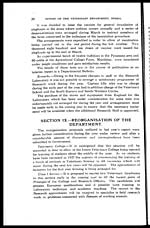Medicine - Veterinary > Civil Veterinary Departments > 1910-1941 - Annual report on the Civil Veterinary Department, Burma (including the Insein Veterinary School) > 1923-1931 > 1930
(367) Page 29
Download files
Individual page:
Thumbnail gallery: Grid view | List view

FOR THE YEAR ENDED THE 31ST MARCH 1930. 29
Nematodes—concld.
|
9. |
Filaria Labito papillosa ... ... |
Cattle. |
|
10. |
Filaria œculi (Larvæe of above) ... |
Horses. |
|
11. |
Filaria Immitis ... ... |
Dogs. |
|
Cestodes. |
||
|
1. |
Tænia alba ... ... ... |
Cattle, sheep and goats. |
|
2. |
Dipylidin Caninun ... ... |
Dogs. |
|
3. |
Cysticercus Tennuicollis ... ... |
Sheep. |
|
Trcmalodes. |
||
|
1. |
Distoma ... ... ... |
Sheep. |
|
2. |
Amphistoma Conicum ... ... |
Cattle and goats. |
It is proposed that this work will be continued by Mr. Bhattacharjee
when opportunity permits and the results will be published in a Depart-
mental Bulletin.
Rinderpest.—A strain of rinderpest was maintained in cattle at the
Laboratory for part of the year in anticipation of being able to introduce
the Serum-Virus method of protective inoculation in the districts. This
was not found possible owing to administrative and technical difficulties
A small lot of 6 bulls being sent to Arakan on a breeding improvement
scheme were immunised succssfully at the request of the Director of
Agriculture by the Serum-Virus method.
The maintenance of a strain of Rinderpest in Burmese cattle was
found to be a very difficult problem owing to the relatively high
immunity of these cattle and it was only possible to keep the strain
going with the aid of cattle purchased from jail herds where the
animals had been bred under disease free conditions. As the supply of
these animals is too limited to meet the demands when the method is
introduced into practice an enquiry was initiated to ascertain if cattle
susceptible to rinderpest were available in any part of Burma or
adjoining islands from which a constant supply could be arranged.
This investigation was in progress at the close of the year. A guaran-
teed supply of susceptible cattle is essential for the serum-virus method
of rinderpest immunisation.
Anthrax.—Experimental work on animals to ascertain the safety
and protective value of the Anthrax Vaccine prepared at the Insein
Laboratory was carried out during the year. The test animals included
elephants, cattle, buffaloes and sheep. Preliminary tests were made
on sheep and cattle at the Laboratory.
Tests on the safety of the vaccine in elephants were conducted on
19 animals belonging to Timber Firms during May and July and as the
results were promising a crucial test was arranged in December in
elephants at Shwenyaungbin near Tonngoo on six elephants and two
goats offered by the timber firms. These experiments were successful
and demonstrated that the vaccine was safe to use and conferred a
very strong immunity to the disease (injection of virulent cultures) one
month after inoculation.
Set display mode to: Large image | Zoom image | Transcription
Images and transcriptions on this page, including medium image downloads, may be used under the Creative Commons Attribution 4.0 International Licence unless otherwise stated. ![]()
| Permanent URL | https://digital.nls.uk/75809498 |
|---|




